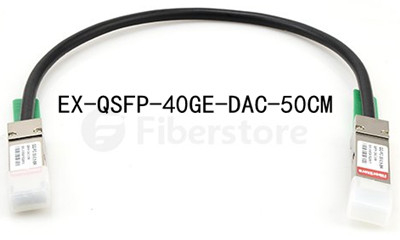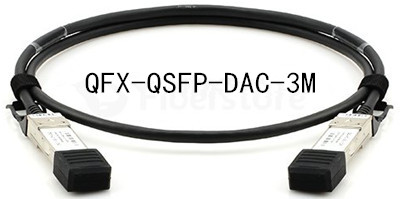The increasing bandwidth demands in data centers call for new cost-effective network solutions that are able to provide great bandwidth and improved power efficiency. As such, direct attach cables (DACs) are designed to replace expensive fiber optic cables in some Ethernet applications, like choosing SFP+ DACs and QSFP+ DACs accordingly as 10 Gigabit Ethernet (GbE) and 40GbE cabling solutions to achieve high performance. How much do you know about this kind of cable? Do you know its such basic information as classifications? If not, then you can follow this article to understand DAC in depth based on the two main questions.
DAC, a kind of optical transceiver assembly, is a form of high speed cable with “transceivers” on either end used to connect switches to routers or servers. Often referred to as twin-ax, this direct attach twin-axial cable is very similar to coaxial cable, except for one additional copper conductor core. DACs are much cheaper than the regular optics, since the “transceivers” on both ends of DACs are not real optics and their components are without optical lasers. In some 10GbE and 40GbE infrastructures, DACs have been selected to replace fiber optic patch cord when the required link length is relatively short. And in storage area network, data center, and high-performance computing connectivity, DACs are preferable choice because of their low cost, low power consumption and high performances.
When it comes to DAC’s classifications, there exist two primary standards: Ethernet transmission rate, material of cables.
Based on Ethernet transmission rate and construction standard, 10G SFP+ DACs, 40G QSFP+ DACs, and 120G CXP+ DACs are all available, meaning that DAC can be used as transmission medium for 10GbE, 40GbE, and 120GbE applications when combined as transceivers. Typical DAC assemblies have one connector on each end of the cable. Take SFP-10G-AOC1M for example, this Cisco compatible SFP+ to SFP+ Direct-Attach Active Optical Cable assembly has one SFP+ connector on each end of the cable, designed for relatively short reach that is 1m.

According to material of cables used, DACs are available in direct attach copper cables and active optical cables (AOCs).
Direct Attach Copper Cable
Direct attach copper cables are designed in either active or passive versions, providing flexibility with a choice of 1-, 3-, 5-, 7-, and 10-meter lengths. The former provides signal processing electronics to avoid signal issue, thus to improve signal quality. What’s more, the former can transmit data over a longer distance than the latter which offers a direct electrical connection between corresponding cable ends. Both direct attach passive copper cables and direct attach active copper cables have gained popularity in data centers. For instance, EX-QSFP-40GE-DAC-50CM, the Juniper 40G cabling product, hot-removable and hot-insertable, is the QSFP+ to QSFP+ direct attach passive copper cable assembly, really suitable for short distances of up to 0.5m(1.6ft), appropriate for highly cost-effective networking connectivity within a rack and between adjacent racks.

Active Optical Cable
AOC is also one form of DAC. It uses electrical-to-optical conversion on the cable ends to improve speed and distance performance of the cable while mating with electrical interface standard. Compared with direct attach copper cable, its smaller size, electromagnetic interference immunity, lower interconnection loss and longer transmission distance make it popular among consumers.
DACs offer great flexibility in cabling length choices, simplify server connectivity in top-of-rack deployments, and reduce the power needed to transmit data. More importantly, DACs ensure high system reliability after going through rigorous qualification and certification testing, helping network designers to achieve new levels of infrastructure consolidation while expanding application and service capabilities.
DACs are able to provide an end-to-end solution that is easy to maintain, thus helping improve the availability of networks that support mission-critical applications. Fiberstore offers a broad selection of DACs with high quality for state-of art performance, 10G SFP+ DACs, 40G QSFP+ DACs, and 120G CXP+ DACs all included. For more information about DACs, you can visit Fiberstore.


